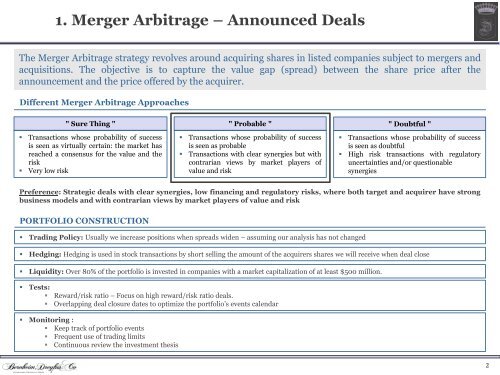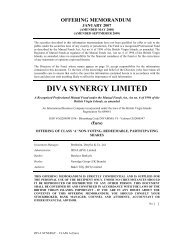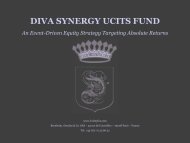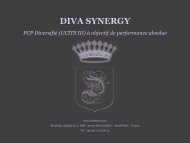DIVA SYNERGY UCITS FUND - Bernheim, Dreyfus & Co.
DIVA SYNERGY UCITS FUND - Bernheim, Dreyfus & Co.
DIVA SYNERGY UCITS FUND - Bernheim, Dreyfus & Co.
Create successful ePaper yourself
Turn your PDF publications into a flip-book with our unique Google optimized e-Paper software.
1. Merger Arbitrage – Announced Deals<br />
The Merger Arbitrage strategy revolves around acquiring shares in listed companies subject to mergers and<br />
acquisitions. The objective is to capture the value gap (spread) between the share price after the<br />
announcement and the price offered by the acquirer.<br />
Different Merger Arbitrage Approaches<br />
" Sure Thing "<br />
• Transactions whose probability of success<br />
is seen as virtually certain: the market has<br />
reached a consensus for the value and the<br />
risk<br />
• Very low risk<br />
" Probable "<br />
• Transactions whose probability of success<br />
is seen as probable<br />
• Transactions with clear synergies but with<br />
contrarian views by market players of<br />
value and risk<br />
" Doubtful "<br />
• Transactions whose probability of success<br />
is seen as doubtful<br />
• High risk transactions with regulatory<br />
uncertainties and/or questionable<br />
synergies<br />
Preference: Strategic deals with clear synergies, low financing and regulatory risks, where both target and acquirer have strong<br />
business models and with contrarian views by market players of value and risk<br />
PORTFOLIO CONSTRUCTION<br />
• Trading Policy: Usually we increase positions when spreads widen – assuming our analysis has not changed<br />
• Hedging: Hedging is used in stock transactions by short selling the amount of the acquirers shares we will receive when deal close<br />
• Liquidity: Over 80% of the portfolio is invested in companies with a market capitalization of at least $500 million.<br />
• Tests:<br />
• Reward/risk ratio – Focus on high reward/risk ratio deals.<br />
• Overlapping deal closure dates to optimize the portfolio’s events calendar<br />
• Monitoring :<br />
• Keep track of portfolio events<br />
• Frequent use of trading limits<br />
• <strong>Co</strong>ntinuous review the investment thesis<br />
2






